|
|
HEALTHY HAPPENING September 2018
|
What To Know About A Broken Toe
by Dr. Selina Sekulic of Final Kick Ankle & Foot
|
WHAT DOES A BROKEN TOE LOOK LIKE?
When you look down at your foot, your toe will appear bruised and swollen. The toe might even look crooked. The toenail may appear discolored. This is due to blood accumulating under the nail (aka subungual hematoma).
On x-ray, there will be an obvious fracture line. The fractured bone might be in two parts, or in multiple parts. The fracture might even extend into a joint. The bone that has been fractured may appear well aligned, or it may be displaced by several millimeters.
CAN A BROKEN TOE GET INFECTED? 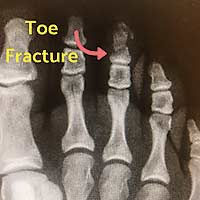
Yes! If your skin was cut during the time of injury, or the nail was damaged, then bacteria can enter the toe and cause an infection. If your skin is cut at the time of injury, it is important to wash the wound well with soap and water. Avoid hydrogen peroxide. I also highly recommend going to an urgent care or foot doctor immediately for a proper washout, and to evaluate the severity of the fracture.
WILL A BROKEN TOE ITCH?
As the broken toe is healing, it might start to itch. This is due to your body releasing histamines to the area during the inflammatory phase of healing. Just think of this as a signal that your body is in the process of remodeling your broken toe.
HOW TO HEAL A BROKEN TOE FASTER?
See a foot specialist immediately! It’s best to get your broken toe evaluated as soon as you can to determine the severity of the fracture. If the fracture is displaced by several millimeters, it should be reduced and then taped in the proper anatomical position. Occasionally, a severely displaced fracture might even require surgery.
The foot specialist can also evaluate the toenail as well as any cuts that might have occurred when the toe was injured. Preemptive measures can then be taken to make sure the toenail is cared for properly, and avoid potential toe infection.
Expect your toe to take at least 6 weeks to be fully healed.
WHY BUDDY TAPE A BROKEN TOE?
Buddy taping is essential for healing a toe fracture. Taping helps to stabilize the two ends of the fracture so that the bone can heal without excessive movement. Think of buddy taping as a cast that you would wear on your broken arm or leg.
It’s always best to tape the 2nd, 3rd, and 4th toes together for stability. For example, if you break your 4th toe, then tape it to the 3rd toe, rather than the 5th toe. The 1st and 5th toes are attached to other bones that have more motion than the bones attached to the 2nd, 3rd, and 4th toes. Excessive motion can impede healing of the 2nd or 4th toes if they were to be buddy taped to the 1stor 5th toes.
WHAT SHOES FOR A BROKEN TOE?
Stiff soled shoes are recommended. This can include supportive sandals, or enclosed shoes. Avoid shoes with narrow toe boxes, and high heels. These types of shoes will not accommodate for swelling, and could displace the fracture even further.
WHY IS MY BROKEN TOE STILL SWOLLEN?
Whenever you have a fracture in your foot, your body will increase blood flow to the area to help with healing. When the extra blood gets congested, it increases pressure in the capillaries (tiny blood vessels), which causes fluid to leak into the surrounding tissues. This results in the swollen appearance of your toe. The swelling will continue to be present until the fracture is healed. This may take 2-3 months.
Dr. Sekulic is a Podiatrist at Moab Regional Health Center's Specialty Clinic. To make an appointment call (385) 770-7203.
|
Yoga Everyday
by –B.K.S Iyengar |
.
A daily practice of any kind can seem intimidating at first, let alone yoga. Yoga carries so many ideas of what it is, that one must be able to touch their toes or stand on their head. The beauty of Yoga is that it can practiced by all; you can be lying in bed, sitting at a desk, climbing a mountain, and all the points between. Truly the first step is the desire and then turning your desire into an action. It is a choice to become present with your body and breath and then overtime, this creates moments that quiet the constant noise of life. We often say we will try something new, ”soon or tomorrow".
How about we practice yoga right now! Wherever you are reading this article:
-Make a commitment for the next two minutes that you will focus on your breath.
-Let the eyes close or rest on a single point.
-Bring a hand to your belly and a hand to your chest.
-Inhale through the nose, exhale out of the nose or the mouth.
-Take five steady breaths into your belly.
-Take five steady breaths into your chest.
-Now five breaths bringing those two areas together.
-Use the remainder of the your time to sit quietly.
-How do you feel? |
Fantastic! You just practiced Yoga, a limb of the practice called Pranayama.
The daily practice of yoga strengthens and relaxes the physical body, the muscles, cleanses the organs, improves digestion, sleep, and balance, as well as, steadies the mind. Yoga has been practiced for thousands of years. In recent years the studies by doctors and universities are astounding and they conclude that the benefits range from relaxing, enjoyable, healing, and profound.
Whether you are new to yoga or experienced in yoga we look forward to practicing with you. Join us any day or everyday of the week at Moab Yoga 37 E Center St. 435-259-2455. www.moabyoga.com
“Change is not something that we should fear. Rather, it is something that we should welcome. For without change, nothing in this world would ever grow or blossom, and no one in this world would ever move forward to become the person they’re meant to be.”
|
Moab Regional Hospital Names
New Chief Medical Officer |
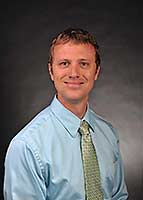 Dylan Cole, DO, has been selected as the new Chief Medical Officer for Moab Regional Hospital. He will replace Steven Rouzer, MD, who recently completed his two-year term. Dylan Cole, DO, has been selected as the new Chief Medical Officer for Moab Regional Hospital. He will replace Steven Rouzer, MD, who recently completed his two-year term.
The Chief Medical Officer provides medical leadership on the MRH executive team, and works closely with CEO, CFO, CCO and Director of Physician Services to ensure quality hospital operations, develop and drive the strategic plan, provide leadership to the medical providers and improve community health.
Dr. Cole listed his three top priorities as CMO to expand and enhance the services provided, maintain the quality of patient care and improve access to care within the Moab community. “I would like to see our hospital continue to explore opportunities to reduce costs and enhance our charitable mission” Cole stated.
A native of Utah, his education began at University of Utah and continued at Touro College of Osteopathic Medicine in California. He completed his residency at Idaho State University Family Medicine in Pocatello. Dr. Cole and wife Desiree Westfall, PA (also a provider at Moab Regional Health Center) are raising their children Galen and Mia here in Moab.
Dinner with a Doc
September 11th 6:00pm - 7:00pm
Joshua Canning M.D. is a medical Toxicologist and ER Physician in Phoenix. He is giving a free lecture on identification and first aid of snakes, spiders, and scorpions bites. This presentation promises to be of interest to guides, outdoorsmen, and anyone who lives in the desert and has the potential of encountering "snakes, spiders, and scorpions".
RSVP requested vista@mfhmoab.org
or call (435) 719-5580 |
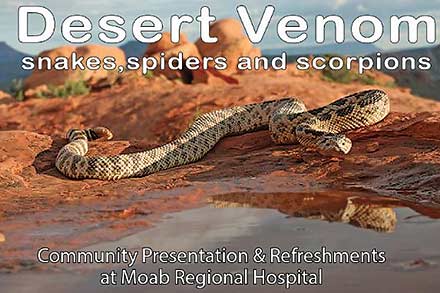 |
|
Meet Greg & Marty:
The Farmers of Paradox Produce
|
Humility, tenacity, and deep compassion. Greg Spaulding and Marty Warner, dedicated farmers of Colorado’s Paradox Valley and active members of the Paradox community, embody these characteristics in all aspects of their lives. On June 21st, 2018, I spent a couple hours learning more about these inspiring humans and their impressive farming and beekeeping operations. They only work with wild honeybee colonies by setting several traps in the area.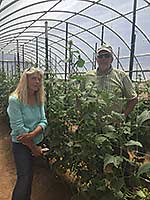
Driving into Paradox to meet them at their farmstead required traversing along steep switchbacks and somewhat treacherous segments of road under construction. I greeted Greg and Marty and immediately felt welcome. We discussed their individual journeys that led them to Paradox and their motivations for farming, especially in a contemporary food system which presents challenges to the average small-scale farmer.
Marty and Greg both grew up with a deep admiration for and gravitation toward growing food. Marty, a Midwesterner born and raised on a farm in Ohio, moved to Manhattan immediately after high school and eventually landed in the Hudson Valley. She worked on Moody Hill Farms, the largest certified organic farm in New York State. Founded by compost expert Karl Hammer, they boasted a massive composting operation using scraps from the nearby Culinary Institute of America and used coffee grounds from Nestle’s. They sold produce to several dozen New York City restaurants and distributed compost and soil blends along the east coast. Moody Hill Farms’ compost and soil operations would eventually evolve into McEnroe Organics. Greg grew up in the Montrose Country region and spent a substantial amount of time in the area despite moving around often as the child of a military father. He attended high school and college in Indiana but continued spending time in western Colorado. He decided that he wanted to permanently reside in the area instead of merely visiting on occasion. He worked in the forestry field for about 10 years. Ultimately, they both ended up in Lake Powell. She decided to follow the splendor of the southwest and accepted a temporary job there, where she met Greg. She noticed the abundance of potted peppers and tomatoes on his small porch when she first visited him and thought, “Uh oh… this might be him.” They bonded over their passion for growing food and decided to dedicate their lives to farming.
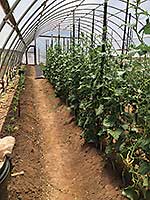 As they began their quest to establish a farm, they settled on Paradox, one of the most affordable area throughout the region, from southeast Utah to western slope Colorado. Fortunately, they own water shares in the spring, which often remain unaffected by fluctuating drought patterns. They were impacted heavily by the 2008 financial crisis, and Greg faced the consequences of the boom and bust cycle of the mining industry and lost his job. They decided to reinvent themselves and focus primarily on growing produce and beekeeping. They typically grow produce year round, focusing on lettuce, cucumbers, and several nightshade varieties. They did sell at farmers’ markets for several years in Norwood, CO but ultimately decided to focus on selling to Moonflower Co-op and local restaurants through USU Extension’s Farm-Chef-Fork program developed by Shiree Duncan. As they began their quest to establish a farm, they settled on Paradox, one of the most affordable area throughout the region, from southeast Utah to western slope Colorado. Fortunately, they own water shares in the spring, which often remain unaffected by fluctuating drought patterns. They were impacted heavily by the 2008 financial crisis, and Greg faced the consequences of the boom and bust cycle of the mining industry and lost his job. They decided to reinvent themselves and focus primarily on growing produce and beekeeping. They typically grow produce year round, focusing on lettuce, cucumbers, and several nightshade varieties. They did sell at farmers’ markets for several years in Norwood, CO but ultimately decided to focus on selling to Moonflower Co-op and local restaurants through USU Extension’s Farm-Chef-Fork program developed by Shiree Duncan.
Greg and Marty, like many farmers with small-scale, sustainable, and chemical-free operations, experience the impacts of the industrialized food distribution system. They struggle to compete with distributors who have monopolized both the conventional and organic produce markets, but they continue to dedicate themselves to producing nutritious, tasty vegetables for their local community. By adapting to the challenges of the food system and experimenting with different models, techniques, and ideas, they continue to grow and thrive within a challenging profit-driven system. They plan to construct another greenhouse and work toward opening their Paradox Mercantile in the near future. Anyone can visit Moonflower Co-op to buy some of their lovingly cultivated produce and directly support the dedicated growers in our local foodshed.
|
| |
|
|
|
|
|
|
© 2002-2024 Moab Happenings. All rights
reserved.
Reproduction of information contained in this site is
expressly prohibited.
|
|